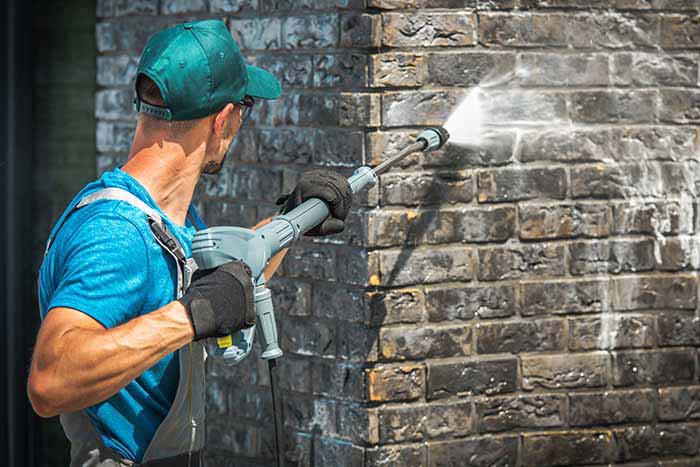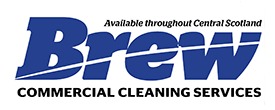Pressure washers (or power washers) are often used to spruce up various items and areas around the house, from patio furniture to cars.
However, we know some of you might still be apprehensive about using a pressure washer, worrying it’s too complex, costly, or tricky to handle.
But here’s the good news: it’s none of those things!
This article is your all-in-one guide to getting started with pressure washing, whether you’re dipping your toes in for the first time or literally getting your feet wet.
Pressure washing is an efficient way to quickly tackle accumulated grime, mud, mould, and mildew on various surfaces. As your reliable partner, we at Brew Contract Cleaning offer high-quality and dependable pressure washing service in Glasgow for residential, commercial, and industrial needs.
Using a pressure washer without the proper know-how can lead to damage. It’s crucial to educate yourself before diving in. If you’re new to pressure washing, you’re on the right page.
In this guide, we’ll cover:
How do pressure washers work
How to connect a hose to your pressure washer
Choosing the right pressure and flow rate
What motor type should you pick for your pressure washer
Things to consider before you start cleaning with your pressure washer
Pressure washer uses for your home
Essential safety tips for power washing
Techniques for cleaning various surfaces
Ready to start on your own power-washing journey? Keep reading for a quick guide on how to get started.

How do pressure washers work
Pressure washers utilise a motor or engine to power a pump, which pressurises water from a connected source. This high-pressure water is then directed through a nozzle at the end of a wand, enabling effective and thorough cleaning. The velocity of the water ensures that dirt and debris are forcefully removed from surfaces.
Connecting a hose to your pressure washer
To ensure your pressure washer functions smoothly, connecting the hose properly is essential.
First, check the pressure of your water supply—ideally, it should be around 3 gallons per minute. Attach a coupler to your garden hose by twisting it onto the hose’s end. Once it’s secure, you can connect it to various attachments on the pressure washer. Insert the hose into the water inlet of the washer and tighten it to guarantee a leak-free connection, and you’re ready to go!
Choosing the right pressure and flow rate
Selecting the appropriate pressure washer depends on what you’re cleaning and how often.
Consider the level of dirtiness and the types of surfaces you’ll be dealing with, as both pressure and flow rate are critical for effective cleaning.
Higher pressures are great for tough dirt on durable surfaces like concrete, while a higher flow rate can expedite tasks like car washing.
Refer to the accompanying table to find the best pressure washer for light, medium, or heavy-duty tasks. Remember, most models allow you to adjust the pressure to suit different tasks.
What motor type should you pick for your pressure washer
Understanding the different motor types in pressure washers can aid in making a more informed decision. Brush motors, while affordable, may wear down due to friction.
Universal motors are compact and fast but tend to be noisier with a shorter lifespan. Induction motors, however, run quietly and last longer, providing durability and reliability for frequent use.
Consider these factors to choose a washer that meets your cleaning needs and ensures long-term performance.

Steps to take before starting to cleaning with a pressure washer
Here are some essential pointers to keep in mind before you kick off your first pressure-washing project:
Safety first
Always wear closed-toe shoes and pants to shield your feet and lower legs from any stray, high-pressure sprays, which can sting or even break the skin if they hit directly.
Cleaning strategy
Start from the top and work your way down. If you’re tackling multiple surfaces, begin with the higher ones like railings or patio umbrellas and then move to lower areas such as decks and patios.
Test first
Begin with a low-key test in a less visible area, like behind a pillow or under the patio furniture. If it’s your first time pressure washing a particular type of surface or material, start with a low pressure.
You can gradually increase the intensity by moving the wand closer or switching nozzles, just to ensure you don’t damage anything. Never start with the nozzle too close.
Handle with care
Be cautious around sensitive materials like windows, softwoods, and vinyl siding, which can easily be damaged by excessive pressure.
We usually stick to cleaning robust materials like concrete, outdoor stone or tiles, composite decking, brick paths, and both outdoor and indoor textiles. Keep the nozzle further from fabrics than you would from harder surfaces like concrete.
Watch your cords
A pressure washer is light and easy to move around–so always keep an eye on your power cord and water hoses to avoid kinks and eliminate tripping hazards.

Pressure washer uses for your home in Glasgow
Pressure washers are versatile tools that can tackle a wide range of cleaning tasks, helping to rejuvenate your home and garden.
Whether you’re considering rolling up your sleeves or still pondering if it’s a DIY project, here are seven great ways you can use a pressure washer.
While these tips might inspire you to try it yourself, remember that hiring a professional cleaner, like us at Brew Contract Cleaning, will yield even better results, with less hassle and risk.
Decking cleaning
Over time, decks can accumulate a lot of dirt and residue. A pressure washer can clean deep into the wood, restoring its appearance.
But getting the pressure right is crucial to avoid damaging the wood. That’s something our pros are trained to handle perfectly.
Driveway cleaning and garage floors
Oil stains, mud, and other stubborn marks can make driveways and garage floors look shabby. A pressure washer can lift these unsightly blemishes with ease.
Our team at Brew knows exactly how to remove tough stains without harming the concrete.
Cleaning outdoor furniture
Whether it’s plastic, wood, or metal, outdoor furniture can be refreshed with a good pressure wash.
However, different materials require different pressure settings to prevent damage, something our skilled technicians are well-versed in.
Washing the exterior of your home
From vinyl siding to brick walls, a pressure washer can make your home’s exterior look new again. It’s important to use the right techniques and pressures to avoid water damage—expertise that our team brings to every job.
Pavers and patio cleaning
Algae and weather stains can detract from the beauty of your patios and pavers.
Our pressure washing Glasgow services can restore your patio’s appearance, but it’s easy to dislodge or damage paving stones if not done correctly.
Fence and roof cleaning
Pressure washing can bring new life to a grimy fence, enhancing curb appeal. Our team ensures that the cleaning process doesn’t strip away paints or finishes.
Washing vehicles
From cars to boats and RVs, a thorough pressure wash can remove road salts and grime that regular washing misses. However, too much pressure can lead to scratches or paint damage.
Essential safety tips for pressure washing
Power washing services can be incredibly effective for cleaning and maintaining your home’s exterior, but it’s important to handle the equipment safely to prevent accidents and damage.
Here are some essential safety tips to keep in mind when using a pressure washer:
Read the manual: Before you start, always read the manufacturer’s manual. Each model can vary significantly in operation and safety features. Understanding your specific pressure washer is the first step to using it safely.
Wear protective gear: Always wear protective clothing when operating a pressure washer. This includes goggles or safety glasses to protect your eyes from debris, sturdy gloves to improve grip and protect your hands, and ear protection if you’re using a particularly loud model. Closed-toe shoes and long pants will also shield you from high-pressure water streams and ricocheting debris.
Check the equipment: Before use, inspect the pressure washer for any signs of wear or damage, especially the hose. A damaged hose can burst under high pressure, creating a dangerous situation.
Start with low pressure: Begin with the lowest pressure setting and adjust gradually as needed. This approach helps prevent damage to the surface being cleaned and allows you to get a feel for the washer’s handling.
Never spray people or pets: The high pressure of the water can cause serious injuries. Always ensure that children and pets are indoors or at a safe distance from the area where you’re working.
Avoid ladders: The recoil on a pressure washer can unbalance you, making it dangerous to use while on a ladder. Instead, use extension wands or attachments to reach high areas safely from the ground.
Use the correct nozzles and techniques: Different cleaning tasks require different nozzles and techniques. Using the wrong nozzle or technique can damage surfaces or not clean effectively. Make sure you’re familiar with which nozzle to use for your specific task.
Be mindful of electrical hazards: Avoid spraying near electrical meters, outlets, and external lights. Keep the electric cord and plug of an electric washer dry and off the ground. Use a circuit protected by a ground fault circuit interrupter (GFCI) to prevent shocks.
Handle chemicals safely: If you’re using detergents or other chemicals, make sure to handle them carefully. Use only solutions approved for pressure washers, as other chemicals can damage the machine or the environment.
Secure your cleaning area: Before starting, remove obstacles that could cause you to trip or fall. Securely close all windows and doors to prevent water from entering your home.
By following these safety tips, you can ensure that your power washing activities are as safe as they are effective, protecting both you and the surfaces you are cleaning.

Pressure washing techniques for various surfaces
Cleaning different surfaces with a pressure washer requires varying techniques to ensure effective cleaning while avoiding damage.
Here’s a guide to help you approach various common surfaces safely and efficiently:
1. Pressure washing concrete driveways and sidewalks
Preparation: Sweep away loose debris and cover nearby plants with plastic sheeting to protect them from the high-pressure spray and any cleaning chemicals.
Technique: Use a rotating or turbo nozzle for deep cleaning since concrete can handle higher pressures. Keep the nozzle at least 12 inches away from the surface and use a steady, sweeping motion to prevent streaking.
Tip: For stubborn stains like oil or grease, pretreat the area with a detergent designed for pressure washers before you start.
2. Pressure washing wood decks and fences
Preparation: Clear the deck of furniture and other items. Wet the wood before applying any cleaner to prevent it from absorbing the chemicals.
Technique: Use a fan nozzle with a wider angle to distribute pressure over a larger area, reducing the risk of damaging the wood. Maintain a consistent distance and angle to ensure an even clean.
Tip: Always spray along the grain of the wood to avoid splintering and to achieve the best cleaning results.
3. Vinyl siding
Preparation: Close all windows and doors, and cover any bushes or plants near the house.
Technique: Use a lower pressure setting with a wider spray pattern to avoid denting or cracking the siding. Start from the top and work your way down to prevent streaks.
Tip: Apply a cleaning solution from bottom to top and rinse from top to bottom to avoid streaking.
4. Cars and boats
Preparation: Make sure all windows are closed and the vehicle is in a suitable location for washing.
Technique: Use a gentle spray setting with a 40-degree nozzle to avoid damaging the paintwork. Keep the spray at least 18 inches away from the vehicle and move closer only if necessary.
Tip: Use a foam cannon attachment for a thorough cleaning and to ensure the detergent is evenly distributed before rinsing.
5. Patios and outdoor tiles
Preparation: Remove furniture, decor, and other movable items. Sweep the surface to remove loose dirt.
Technique: Use a surface cleaner attachment for large areas to get a uniform clean without streaks. For smaller or more delicate tiles, a standard nozzle with moderate pressure may be more appropriate.
Tip: Test the pressure on a hidden corner to ensure it doesn’t damage the grouting or the tile itself.
6. Outdoor furniture
Preparation: Remove cushions and any soft coverings.
Technique: Depending on the material, adjust the pressure accordingly. Use a lower pressure for plastics and painted surfaces to prevent damage.
Tip: Angle the spray downward when cleaning furniture to avoid driving dirt into the surfaces.
7. Windows
Preparation: Ensure the windows are shut and check for any cracks where water might seep through.
Technique: Use a low-pressure setting with a fan nozzle from a distance to avoid breaking the glass. Never use high pressure on windows.
Tip: It’s often better to use a window vac or squeegee for cleaning windows after a gentle rinse with a pressure washer.
By adapting your pressure washing technique according to the type of surface, you can maximise cleaning efficiency while minimising the risk of damage.
Always remember that less pressure is often better until you’re certain the surface can handle more.

Pressure washing services in Glasgow
If mastering the nuances of pressure washing different surfaces sounds like a lot to manage, why not let the professionals handle it?
We specialise in providing top-notch pressure washing services that ensure your property looks its best without the risk of damage. Our team is trained to select the right techniques and pressures for various materials, giving you peace of mind and spotless results. In addition, we can also provide:
Our pressure cleaning service is available throughout the Glasgow and Edinburgh area and most of Central Scotland. Please contact us directly for inquiries.
Ready to see your home or business sparkle?
Contact Brew Contract Cleaning today for a consultation, and let us do the hard work for you.
Enjoy a cleaner, brighter property without lifting a finger!
Contact Us For Free Quote
Edinburgh and Central Scotland
